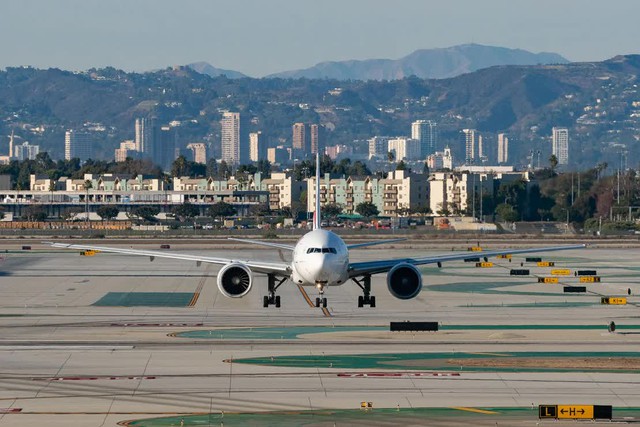This may be great news economically, but some experts fear that a return to the status quo of robust tourism growth will have serious environmental and social consequences.

The concept of a “carbon passport” focuses on tourists being given an annual carbon allowance. Photo: CNN
The summer has seen record-breaking heatwaves across much of the world. Tourists have even fled wildfires in Greece and Hawaii, while extreme weather warnings have spread to popular holiday destinations such as Portugal, Spain and Turkey. Experts have blamed the extreme conditions on climate change.
Tourism is part of the problem. The tourism industry generates about one-tenth of the greenhouse gas emissions that contribute to the climate crisis.
The negative impacts of tourism on the environment have become so serious that some argue that drastic changes to our travel habits are inevitable.
A 2023 report analyzing the future of sustainable travel, by tour operator Intrepid Travel, suggested that “carbon passports” could soon become a reality if the tourism industry hopes to grow.
Carbon passport idea
The idea behind a carbon passport is that each tourist is given a carbon allowance each year that cannot be exceeded. These allowances are then likened to travel “rations.”

The aviation industry is causing large carbon emissions. Photo: CNN
The concept may seem extreme. But the idea of personal carbon allowances is not new. A similar concept (called “personal carbon trading”) was discussed in the UK Parliament in 2008 but was not implemented because of its complexity and the potential for public opposition.
The average person in the US emits 16 tonnes of carbon a year – one of the highest rates in the world. In the UK, the figure is 11.7 tonnes, still five times higher than the target set in the Paris Agreement to keep global temperature rises below 1.5°C (2.7°F) above pre-industrial levels.
Globally, the average person’s annual carbon emissions are around 4 tonnes. However, to meet the 1.5°C target, the global average carbon emissions need to fall below 2 tonnes by 2050. This is equivalent to about two round-trip flights between London and New York.
A report by Intrepid Travel predicts carbon passports are likely to be implemented by 2040. A number of laws and restrictions introduced over the past year have shown that our travel habits may be about to change.
Air travel goals
Between 2013 and 2018, CO₂ emissions from commercial aircraft worldwide increased by 32%. Improvements in fuel efficiency are reducing emissions per passenger. Research from 2014 also found that despite efforts to reduce carbon emissions, the world is being severely impacted by the growth in air traffic.
For emissions to be meaningfully reduced, ticket prices would have to rise by 1.4% a year, so some people would be reluctant to fly. But in fact, ticket prices have been falling.
Several European countries are starting to take measures to limit air travel. From April 1, 2023, passengers on short-haul flights and older aircraft in Belgium will face increased taxes to encourage alternative means of travel.
Less than two months later, France banned short-haul domestic flights, where the same trip could be made by train in 2.5 hours or less. Spain is expected to follow suit.
A similar plan could also be implemented in Germany. In 2021, a YouGov poll found that 70% of Germans would support these climate change measures if alternative transport routes such as trains or boats were available.
Yachts and carbon
It’s not just air travel that’s being criticized. A 2023 study by the European Transport and Environment Federation found that cruise ships are pumping four times more sulfur dioxide into the atmosphere (which has been shown to cause acid rain and some respiratory diseases) than Europe’s roughly 291 million cars combined.

Slovenia is becoming a popular destination as tourists look for cooler European destinations. Photo: CNN
Such statistics have forced European destinations to take action to curb cruise tourism. In July, Amsterdam council banned cruise ships from docking in the city centre in a bid to reduce tourist numbers and pollution.
In 2019, Venice, a European port, also fell into a pollution slump due to the large number of cruise ships visiting. The famous Italian city dropped to 41st place in 2022 because of pollution. The city government has banned large cruise ships from entering the city's waters in an effort to reduce air pollution from ships in Venice by 80%.
Change destination
Intrepid Travel's report found that not only does the tourism industry pollute the environment through transportation, but the places we travel to will soon be affected by climate change.
Warming temperatures are likely to reduce the appeal of traditional beach destinations, prompting European tourists to seek cooler holiday destinations such as Belgium, Slovenia and Poland.
Several travel companies report a significant increase in holiday bookings to cooler European destinations such as Scandinavia, Ireland and the UK during the peak summer travel months of 2023.
Whatever the solution, changes in travel habits seem inevitable. Destinations around the world, from Barcelona to the Italian Riviera and even Mount Everest, are calling for limits on tourist numbers as they struggle to cope with crowds and pollution.
"Travelers should prepare to change their travel habits now before it's too late," CNN suggests.



































